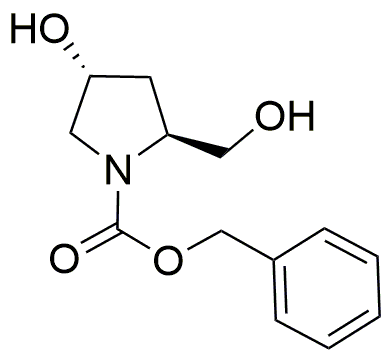N-Carbobenzoxy-trans-4-hydroxy-L-prolinol is widely utilized in research focused on:
- Peptide Synthesis: This compound serves as a protecting group in the synthesis of peptides, allowing for the selective modification of amino acids during chemical reactions.
- Drug Development: It plays a crucial role in the design of pharmaceutical compounds, particularly in creating prodrugs that enhance bioavailability and therapeutic efficacy.
- Biochemical Research: Researchers use it to study enzyme activity and protein interactions, contributing to a better understanding of biological processes.
- Cosmetic Formulations: The compound is incorporated into skincare products for its potential to improve skin hydration and elasticity, making it valuable in the cosmetics industry.
- Material Science: It is explored for use in creating novel materials with specific properties, such as improved mechanical strength or thermal stability.
General Information
Properties
Safety and Regulations
Applications
N-Carbobenzoxy-trans-4-hydroxy-L-prolinol is widely utilized in research focused on:
- Peptide Synthesis: This compound serves as a protecting group in the synthesis of peptides, allowing for the selective modification of amino acids during chemical reactions.
- Drug Development: It plays a crucial role in the design of pharmaceutical compounds, particularly in creating prodrugs that enhance bioavailability and therapeutic efficacy.
- Biochemical Research: Researchers use it to study enzyme activity and protein interactions, contributing to a better understanding of biological processes.
- Cosmetic Formulations: The compound is incorporated into skincare products for its potential to improve skin hydration and elasticity, making it valuable in the cosmetics industry.
- Material Science: It is explored for use in creating novel materials with specific properties, such as improved mechanical strength or thermal stability.
Documents
Safety Data Sheets (SDS)
The SDS provides comprehensive safety information on handling, storage, and disposal of the product.
Product Specification (PS)
The PS provides a comprehensive breakdown of the product’s properties, including chemical composition, physical state, purity, and storage requirements. It also details acceptable quality ranges and the product's intended applications.
Certificates of Analysis (COA)
Search for Certificates of Analysis (COA) by entering the products Lot Number. Lot and Batch Numbers can be found on a product’s label following the words ‘Lot’ or ‘Batch’.
*Catalog Number
*Lot Number
Certificates Of Origin (COO)
This COO confirms the country where the product was manufactured, and also details the materials and components used in it and whether it is derived from natural, synthetic, or other specific sources. This certificate may be required for customs, trade, and regulatory compliance.
*Catalog Number
*Lot Number
Safety Data Sheets (SDS)
The SDS provides comprehensive safety information on handling, storage, and disposal of the product.
DownloadProduct Specification (PS)
The PS provides a comprehensive breakdown of the product’s properties, including chemical composition, physical state, purity, and storage requirements. It also details acceptable quality ranges and the product's intended applications.
DownloadCertificates of Analysis (COA)
Search for Certificates of Analysis (COA) by entering the products Lot Number. Lot and Batch Numbers can be found on a product’s label following the words ‘Lot’ or ‘Batch’.
*Catalog Number
*Lot Number
Certificates Of Origin (COO)
This COO confirms the country where the product was manufactured, and also details the materials and components used in it and whether it is derived from natural, synthetic, or other specific sources. This certificate may be required for customs, trade, and regulatory compliance.


